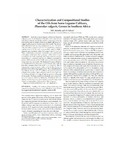Please use this identifier to cite or link to this item:
http://hdl.handle.net/10311/303Full metadata record
| DC Field | Value | Language |
|---|---|---|
| dc.contributor.author | Mabaleha, M.B. | |
| dc.contributor.author | Yeboah, S.O. | |
| dc.date.accessioned | 2009-03-30T06:48:56Z | |
| dc.date.available | 2009-03-30T06:48:56Z | |
| dc.date.issued | 2004 | |
| dc.identifier.citation | Mabaleha, M.B. & Yeboah, S.A. (2004). Characterization and Compositional Studies of the Oils from Some Legume Cultivars, Phaseolus vulgaris, Grown in Southern Africa, JAOCS, Vol. 81, (4), pp, 361-364 | en |
| dc.identifier.issn | 1558-9331 | |
| dc.identifier.uri | http://hdl.handle.net/10311/303 | |
| dc.description.abstract | Seed oils from six legume cultivars of Phaseolus vulgaris, grown in the Kingdom of Lesotho, were extracted and their physicochemical properties and FA compositions were determined in order to compare their dietary lipids with those in P. vulgaris cultivars grown in other parts of the world. The oil content of the beans was very low, ranging from 1.5 to 2.0% (w/w). The acid values ranged from 11.0 to 19.2 mg KOH/g, whereas a combination of the PV and the p-anisidine values in Holm’s equation gave oxidation values that ranged from 11.0 to 15.0. Thus, considerable enzymatic hydrolysis and oxidation had taken place in the beans during storage. Iodine values ranged from 80.5 to 92.3 (Wijs method), indicating moderate unsaturation in the oils. However, capillary GC analysis, supported by proton NMR analysis of the FAME, gave a total unsaturation range from 79.67 to 84.24%. The dominant FA were α-linolenic acid (36.47–48.81%) and linoleic acid (20.96–36.10%), with appreciable amounts of palmitic acid (14.33–18.23%). This FA composition pattern is quite similar to the FA distribution reported for low oil-bearing legume seeds. Thus, notwithstanding the different climatic and soil conditions, the general properties of lipids in the southern African legume cultivars were quite similar to those of lipids in P. vulgaris cultivars grown in other parts of the world. The high content of α-linolenic acid in the cultivars of P. vulgaris could very likely play a beneficial role in reducing the risk of coronary heart disease among the large populations consuming them in the southern African region. | en |
| dc.language.iso | en | en |
| dc.publisher | AOCS Press. | en |
| dc.subject | Capillary GC | en |
| dc.subject | cultivars | en |
| dc.subject | dietary lipids | en |
| dc.subject | fatty acid composition | en |
| dc.subject | legumes | en |
| dc.subject | linoleic acid | en |
| dc.subject | α-linolenic acid | en |
| dc.subject | Phaseolus vulgaris | en |
| dc.subject | physicochemical properties | en |
| dc.subject | proton NMR | en |
| dc.title | Characterization and Compositional Studies of the Oils from Some Legume Cultivars, Phaseolus vulgaris, Grown in Southern Africa | en |
| dc.type | Published Article | en |
| Appears in Collections: | Research articles (Dept of Chemistry) | |
Files in This Item:
| File | Description | Size | Format | |
|---|---|---|---|---|
| Characterization and compositional.pdf | 3.45 MB | Adobe PDF |  View/Open |
Items in DSpace are protected by copyright, with all rights reserved, unless otherwise indicated.
